Abstract
A hemolysin produced by Treponema hyodysenteriae, the etiological agent of swine dysentery, was investigated. A virulent isolate (B204) was inoculated into a standard culture medium consisting of Trypticase soy broth without dextrose (BBL Microbiology Systems) supplemented with 10% fetal calf serum in an atmosphere of 70:30 deoxygenated H2-CO2. Sterile cell-free filtrates were prepared at 2-h intervals and assayed for hemolytic activity by using washed sheep erythrocytes. The maximum hemolytic titer was obtained during the early log phase of growth (4 h). A loss of hemolytic activity was observed when cell-free filtrates were stored at 23 and 4 degrees C. Storage at -20 or -80 degrees C after lyophilization resulted in retention of the hemolytic titer for periods of up to 30 days. Enzymatic inactivation of the hemolysin was accomplished with pronase, but not with deoxyribonuclease, ribonuclease, lipase, or trypsin. Addition of exogenous ribonucleic acid-core to the standard culture medium resulted in a dose-dependent increase in the amount of hemolysin produced. The hemolysin could be purified by acid and ammonium sulfate precipitation followed by ion exchange and molecular sieve chromatography. The molecular weight of the hemolysin was 68,000 when determined by sodium dodecyl sulfate-polyacrylamide slab gel electrophoresis.
Full text
PDF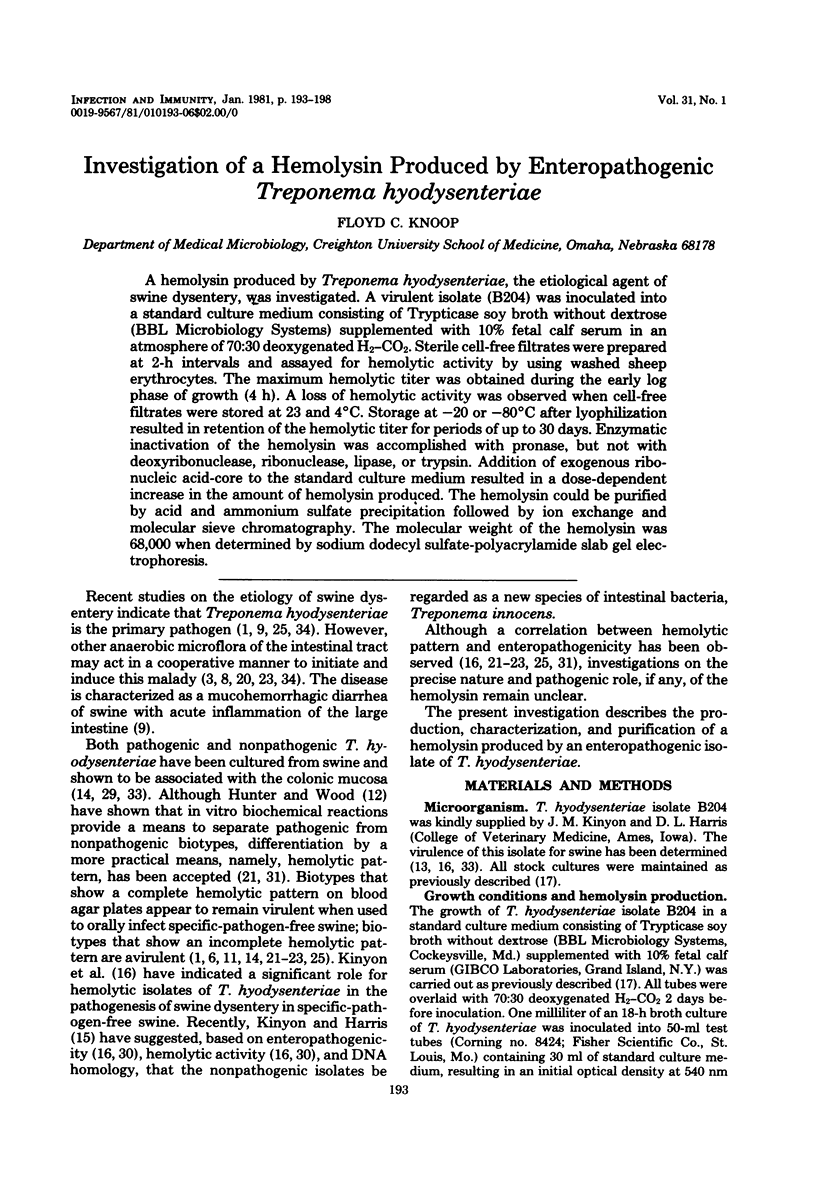
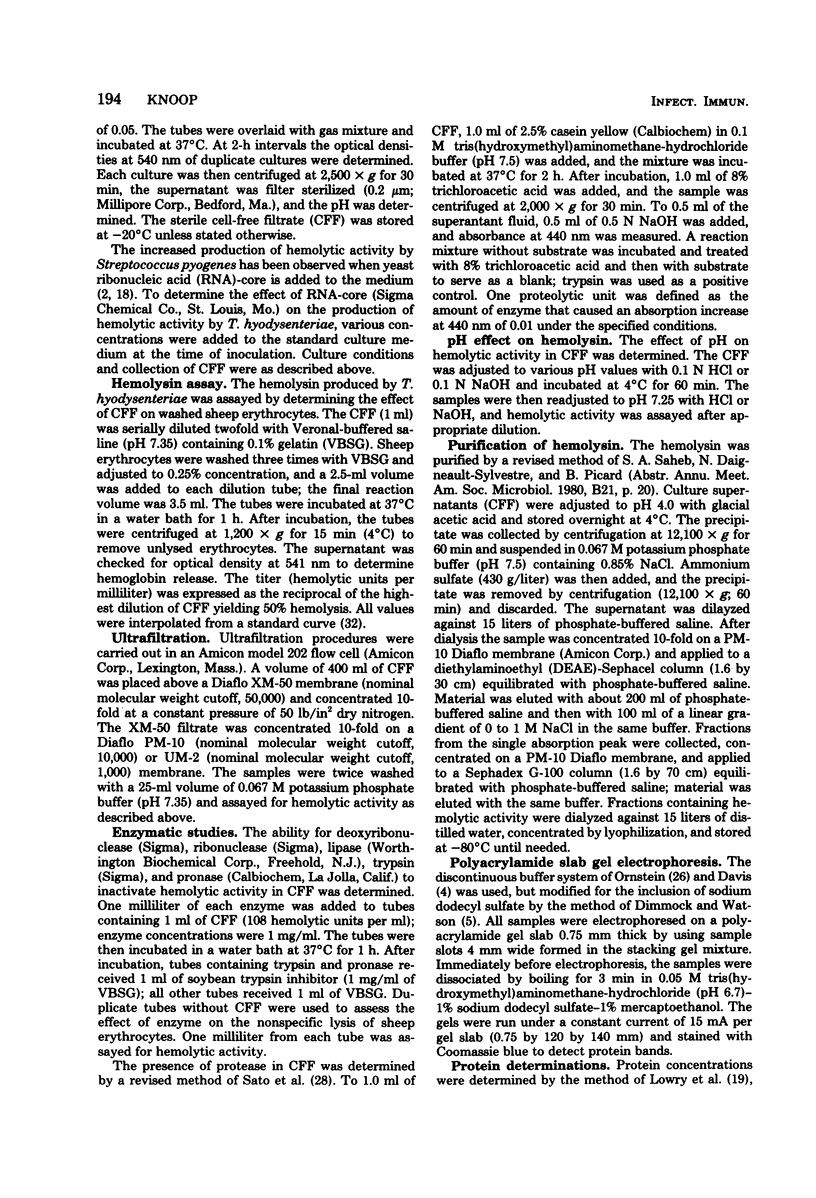
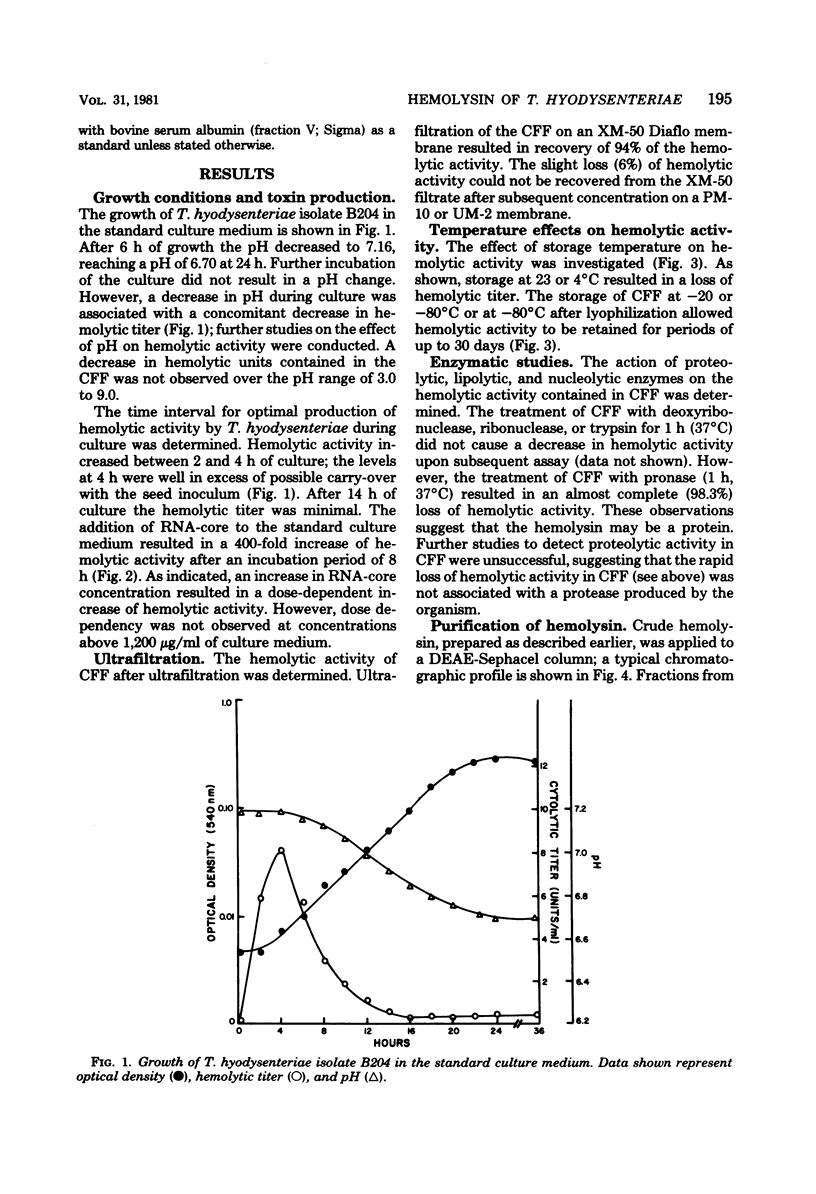

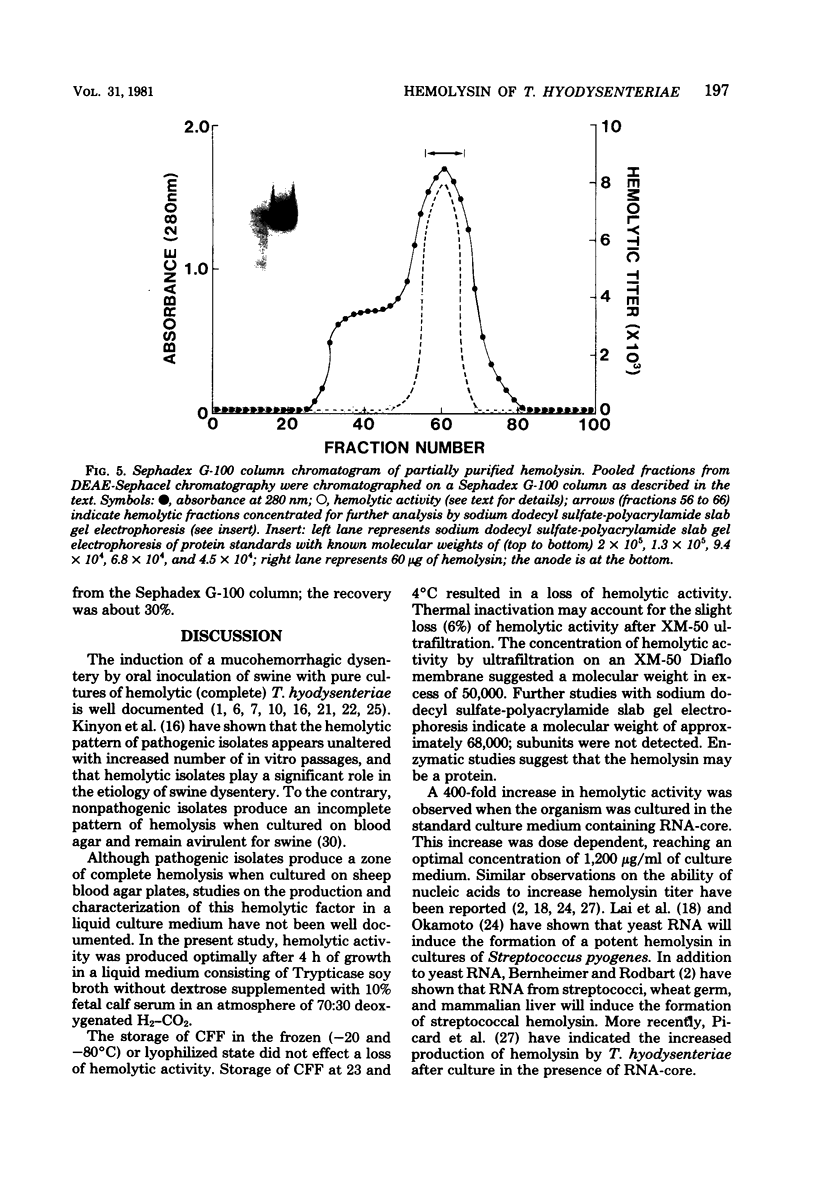
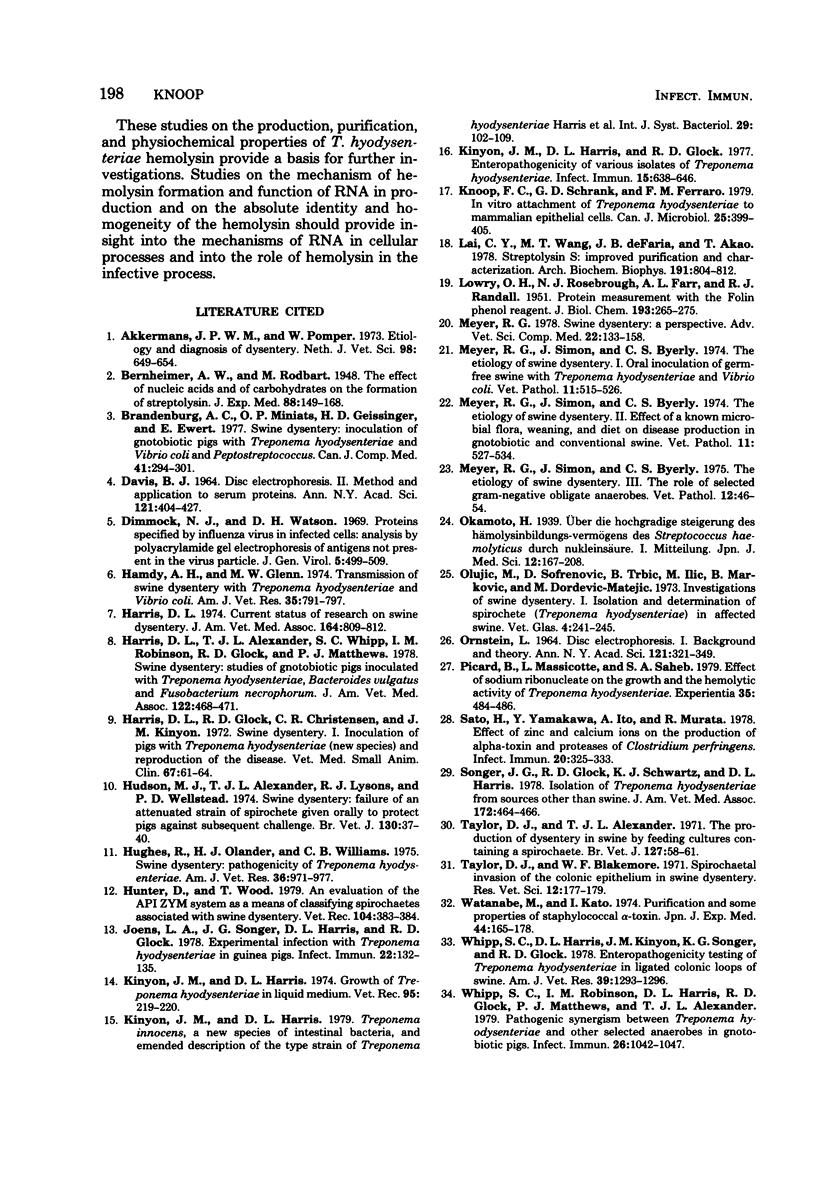
Images in this article
Selected References
These references are in PubMed. This may not be the complete list of references from this article.
- Akkermans J. P., Pomper W. Aetiology and diagnosis of swine dysentery (Doyle). Tijdschr Diergeneeskd. 1973 Jul 15;98(14):649–654. [PubMed] [Google Scholar]
- Brandenburg A. C., Miniats O. P., Geissinger H. D., Ewert E. Swine dysentery: inoculation of gnotobiotic pigs with Treponema hyodysenteriae and Vibrio coli and a Peptostreptococcus. Can J Comp Med. 1977 Jul;41(3):294–301. [PMC free article] [PubMed] [Google Scholar]
- DAVIS B. J. DISC ELECTROPHORESIS. II. METHOD AND APPLICATION TO HUMAN SERUM PROTEINS. Ann N Y Acad Sci. 1964 Dec 28;121:404–427. doi: 10.1111/j.1749-6632.1964.tb14213.x. [DOI] [PubMed] [Google Scholar]
- Hamdy A. H., Glenn M. W. Transmission of swine dysentery with Treponema hyodysenteriae and Vibrio coli. Am J Vet Res. 1974 Jun;35(6):791–797. [PubMed] [Google Scholar]
- Harris D. L., Alexander T. J., Whipp S. C., Robinson I. M., Glock R. D., Matthews P. J. Swine dysentery: studies of gnotobiotic pigs inoculated with Treponema hyodysenteriae, Bacteroides vulgatus, and Fusobacterium necrophorum. J Am Vet Med Assoc. 1978 Feb 15;172(4):468–471. [PubMed] [Google Scholar]
- Harris D. L. Current status of research on swine dysentery. J Am Vet Med Assoc. 1974 Apr 15;164(8):809–812. [PubMed] [Google Scholar]
- Harris D. L., Glock R. D., Christensen C. R., Kinyon J. M. Inoculation of pigs with Treponema hyodysenteriae (new species) and reproduction f the disease. Vet Med Small Anim Clin. 1972 Jan;67(1):61–64. [PubMed] [Google Scholar]
- Hughes R., Olander H. J., Williams C. B. Swine dysentery: pathogenicity of Treponema hyodysenteriae. Am J Vet Res. 1975 Jul;36(7):971–977. [PubMed] [Google Scholar]
- Hunter D., Wood T. An evaluation of the API ZYM system as a means of classifying spirochaetes associated with swine dysentery. Vet Rec. 1979 Apr 28;104(17):383–384. doi: 10.1136/vr.104.17.383. [DOI] [PubMed] [Google Scholar]
- Joens L. A., Songer J. G., Harris D. L., Glock R. D. Experimental infection with Treponema hyodysenteriae in guinea pigs. Infect Immun. 1978 Oct;22(1):132–135. doi: 10.1128/iai.22.1.132-135.1978. [DOI] [PMC free article] [PubMed] [Google Scholar]
- Kinyon J. M., Harris D. L., Glock R. D. Enteropathogenicity of various isolates of Treponema hyodysenteriae. Infect Immun. 1977 Feb;15(2):638–646. doi: 10.1128/iai.15.2.638-646.1977. [DOI] [PMC free article] [PubMed] [Google Scholar]
- Kinyon J. M., Harris D. L. Growth in Treponema hyodysenteriae in liquid medium. Vet Rec. 1974 Sep 7;95(10):219–220. doi: 10.1136/vr.95.10.219. [DOI] [PubMed] [Google Scholar]
- Knoop F. C., Schrank G. D., Ferraro F. M. In vitro attachment of Treponema hyodysenteriae to mammalian epithelial cells. Can J Microbiol. 1979 Mar;25(3):399–405. doi: 10.1139/m79-061. [DOI] [PubMed] [Google Scholar]
- LOWRY O. H., ROSEBROUGH N. J., FARR A. L., RANDALL R. J. Protein measurement with the Folin phenol reagent. J Biol Chem. 1951 Nov;193(1):265–275. [PubMed] [Google Scholar]
- Lai C. Y., Wang M. T., de Faria J. B., Akao T. Streptolysin S: improved purification and characterization. Arch Biochem Biophys. 1978 Dec;191(2):804–812. doi: 10.1016/0003-9861(78)90423-x. [DOI] [PubMed] [Google Scholar]
- Meyer R. C., Simon J., Byerly C. S. The etiology of swine dysentery. I. Oral inoculation of germ-free swine with Treponema hyodysenteriae and Vibrio coli. Vet Pathol. 1974;11(6):515–526. doi: 10.1177/030098587401100606. [DOI] [PubMed] [Google Scholar]
- Meyer R. C., Simon J., Byerly C. S. The etiology of swine dysentery. II. Effect of a known microbial flora, weaning and diet on disease production in gnotobiotic and conventional swine. Vet Pathol. 1974;11(6):527–534. doi: 10.1177/030098587401100607. [DOI] [PubMed] [Google Scholar]
- Meyer R. C., Simon J., Byerly C. S. The etiology of swine dysentery. III. The role of selected gram-negative obligate anaerobes. Vet Pathol. 1975;12(1):46–54. doi: 10.1177/030098587501200107. [DOI] [PubMed] [Google Scholar]
- Meyer R. C. Swine dysentery: a perspective. Adv Vet Sci Comp Med. 1978;22:133–158. [PubMed] [Google Scholar]
- ORNSTEIN L. DISC ELECTROPHORESIS. I. BACKGROUND AND THEORY. Ann N Y Acad Sci. 1964 Dec 28;121:321–349. doi: 10.1111/j.1749-6632.1964.tb14207.x. [DOI] [PubMed] [Google Scholar]
- Picard B., Massicotte L., Saheb S. A. Effet du ribonucléate de sodium sur la croissance et l'activité hémolytique de Treponema hyodysenteriae. Experientia. 1979 Apr 15;35(4):484–486. doi: 10.1007/BF01922721. [DOI] [PubMed] [Google Scholar]
- Sato H., Yamakawa Y., Ito A., Murata R. Effect of zinc and calcium ions on the production of alpha-toxin and proteases by Clostridium perfringens. Infect Immun. 1978 May;20(2):325–333. doi: 10.1128/iai.20.2.325-333.1978. [DOI] [PMC free article] [PubMed] [Google Scholar]
- Songer J. G., Glock R. D., Schwartz K. J., Harris D. L. Isolation of Treponema hyodysenteriae from sources other than swine. J Am Vet Med Assoc. 1978 Feb 15;172(4):464–466. [PubMed] [Google Scholar]
- Taylor D. J., Alexander T. J. The production of dysentery in swine by feeding cultures containing a spirochaete. Br Vet J. 1971 Nov;127(11):58–61. doi: 10.1016/s0007-1935(17)37282-2. [DOI] [PubMed] [Google Scholar]
- Taylor D. J., Blakemore W. F. Spirochaetal invasion of the colonic epithelium in swine dysentery. Res Vet Sci. 1971 Mar;12(2):177–179. [PubMed] [Google Scholar]
- Watanabe M., Kato I. Purification and some properties of staphylococcal alpha-toxin. Jpn J Exp Med. 1974 Apr;44(2):165–178. [PubMed] [Google Scholar]
- Whipp S. C., Harris D. L., Kinyon J. M., Songer J. G., Glock R. D. Enteropathogenicity testing of Treponema hyodysenteriae in ligated colonic loops of swine. Am J Vet Res. 1978 Aug;39(8):1293–1296. [PubMed] [Google Scholar]
- Whipp S. C., Robinson I. M., Harris D. L., Glock R. D., Matthews P. J., Alexander T. J. Pathogenic synergism between Treponema hyodysenteriae and other selected anaerobes in gnotobiotic pigs. Infect Immun. 1979 Dec;26(3):1042–1047. doi: 10.1128/iai.26.3.1042-1047.1979. [DOI] [PMC free article] [PubMed] [Google Scholar]



